A poorly planned kitchen is the worst thing that can happen in your home. For instance, squeaky cabinets and dull paint may take away the joy of cooking. It's easy to feel stuck in the kitchen you've been given because the floor plan and room layout are such firm things.
But you have choices, even if you don't have the money or time to make significant improvements. You can make even the most awful kitchen plans feel useful and, dare we say it, stylish. The trick: just talk to the pros.
The following is a list of the layouts that interior designers consider to be the most challenging to deal with, along with numerous suggestions on how you should layout a kitchen.
Our trusted designers say that the small kitchen, especially its dead-end version, is one of the worst design choices for a kitchen.
Although they're popular, they rank so low for several reasons. According to Jodi Peterman, the owner and CEO of Elizabeth Erin Designs, "When the fridge or stove is trapped at the end of a narrow run, you’re constantly doubling back and bumping into people." It slows down traffic and makes preparing meals feel like a mess.
Sometimes, both ends of a galley kitchen are open, making it feel less closed off. Another expert at Planner 5D based in New York, they can save room in smaller homes, but she also thinks they can make it harder to move around in your home.
The Workaround
If you have a galley kitchen, the most important thing is to make the room look bigger, even if you can't move things around. To make it look more spacious, Peterman says: "Keep counters as clear as possible, add wall-mounted storage to free up space, and swap heavy cabinet doors for open shelving to give the illusion of breathing room."
You can do more things if you have more freedom with building and changes. It's also possible to make the kitchen move better by opening up one side or adding pull-out shelves, and using light colors and mirrors will make the room look bigger.
One-wall kitchens are another type that causes more problems than it solves. The layout is pretty straightforward, which usually consists of just one wall of cabinets and tables, which makes it harder to work and store things.
We all have a reason for the way their kitchen looks. Single-wall choices are less expensive, easier for do-it-yourselfers to build, and can fit in smaller spaces. But they are hard to do because of problems with organization and usefulness.
The Workaround
A countertop and a set of shelves are usually on the same wall. As a result, you'll need to make better use of the things you have and combine storage options.
Moszczynski suggests maximizing vertical storage with tall cabinets and using a mobile island for extra prep space.
If you have lower cabinets, consider installing open shelving to create more room for plates, cups, and cookware. Although this doesn't change the kitchen's shape, it adds much-needed storage.
Tall cabinets and a mobile bench can help you get more prep space, according to Moszczynski. Putting in open shelves could help you get more plates, cups, and cooking tools if your cabinets are low. As long as this doesn't change the shape of the kitchen, it will be even better.
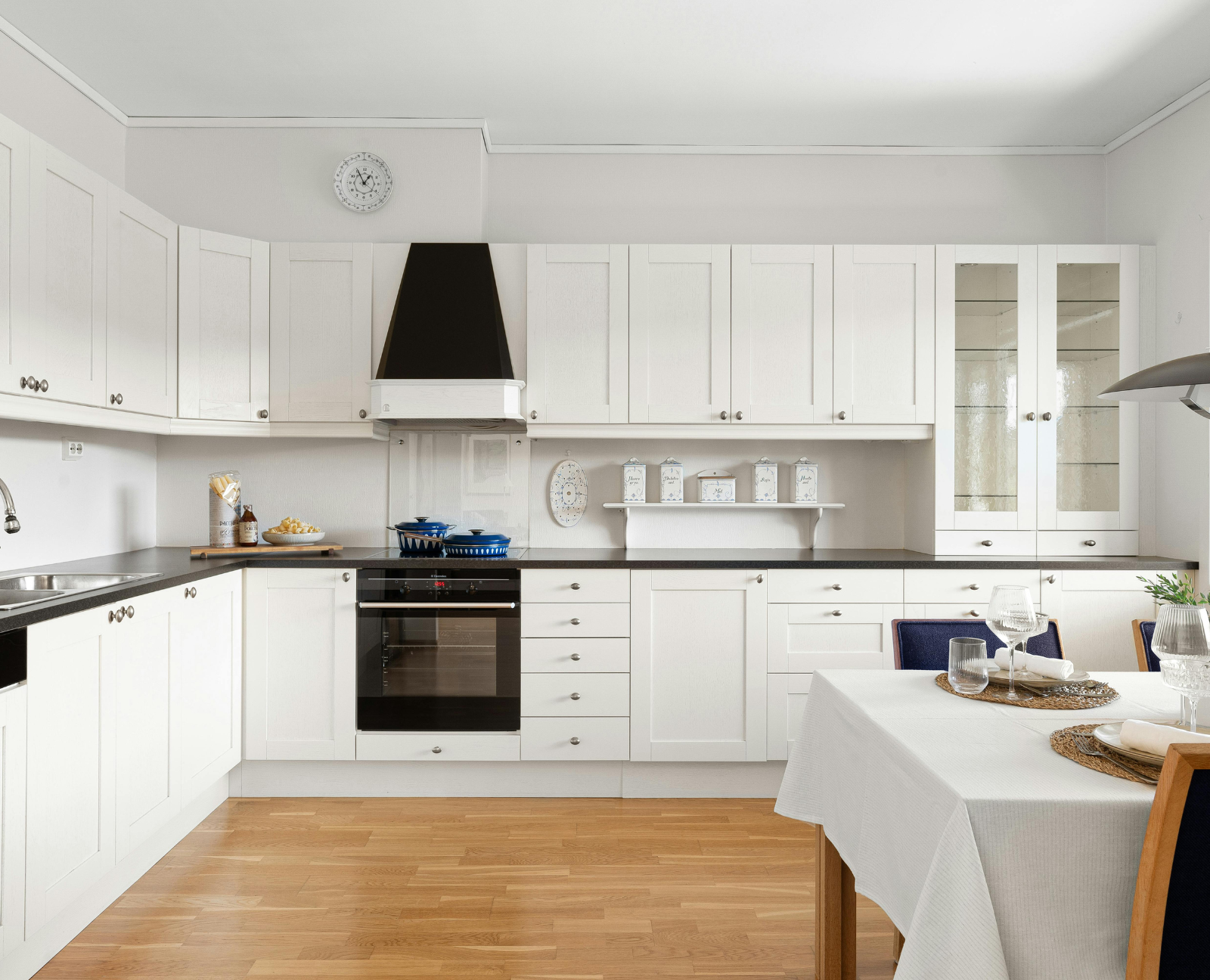
Kitchens almost always have corners. However, certain kitchens have those sneaky places that aren't meant to be used.
Peterman claims: "These awkward diagonal corners have wasted cabinets that no one can reach into without feeling like they’re playing Twister.
The Workaround
Avoiding this type of kitchen may be the best solution. Instead of trying to fix these cabinets, use simpler kitchen organization alternatives.
Rather than stuffing corners, Peterman suggests using them as showcase shelves or decorating them with art or home decor. Invest in sophisticated pull-out organizers elsewhere to avoid impossible cabinet spaces.
You should always praise the kitchen island—right-sized and well-placed islands. A vital cooking room design item can become a barrier if it's too big or placed poorly. According to Peterman, it becomes an obstacle rather than a place where people gather.
The Workaround
She advises keeping it clutter-free, using backless stools that tuck in, and adding wonderful pendant lighting to balance the visual weight. Consider how movement can benefit your kitchen.
Make it your prep station if you need more space.
Make it a modest dining nook if it's too far away.
You cannot change the footprint and focus on making it intentional and easy to traverse. Start with function, then add design to make it fit.
Open-concept kitchens are in demand because open-plan homes are becoming more trendy. These large rooms create good flow and simplify moving between sections and activities. Closed-off kitchens often do the opposite.
"A closed-off kitchen can isolate the cook and can make the space feel smaller," says Moszczynski.
The Workaround
To make this kitchen layout more appealing, you can gather everyone and not let the main cook alone. Adding a table or modest seating area is simple. This allows non-recipe-makers to chat and unwind. There are also proposals for permanent adjustments.
She says: ""I’d play around by removing a wall or adding a partial barrier which can improve connection to other areas and use larger windows and light colors to brighten the space."
"Regardless of any layout—declutter daily, use smart storage solutions, and get good lighting," she added.
Whether you enjoy entertaining, lounging by the pool, or chasing the kids around the yard, a patio should not only look fantastic but also fulfill your family's needs. Even though the best patio design may change depending on the region, designers agree that there are several common patio design aspects they usually avoid (some of which will possibly surprise you).
Designers advise avoiding these six patio elements for a setting that is both practical and fashionable.
The majority of designers surveyed stated that heavy furniture sets were their biggest pet peeve when asked which patio aspects they disliked the most.
We're referring to the identical sets of coffee tables, accent chairs, and sectionals sold in every department shop. In store displays, they might look more attractive and luxurious but when you actually place them in your home, they are bigger than what you’ve expected.
Not only do large outdoor patio furniture sets physically overpower a room, but they can also be inconvenient and provide little adaptability. Rather, smaller sets and modular furniture are more practical and aesthetically pleasant, according to designers.
According to Jodi Peterman, CEO and owner of Erin Elizabeth Designs, using smaller seating options in conjunction with built-in benches or well-placed accent chairs preserves the space's purposeful design while maintaining usefulness.
When the weather warms up, it could be tempting to throw out any old rug on your patio, especially since a high-quality, weather-resistant rug can be exorbitant. Designers advise against placing rugs on your patio that aren't made to last the weather, though.
"It is crucial to get a long-lasting, all-weather rug that adds texture or color and ties everything together because these can look messy and wear out quickly," explains Elizabeth Vergara, CEO and founder of Vergara Homes.
Think about the money you'll save by purchasing high-quality rugs upfront rather than constantly replacing inferior ones.
Designers agree that good lighting doesn't just bring a room together, it also helps improve its functionality. However, many people still overlook having outdoor lighting on their patio.
If you want to maximize the look of your patio, adding string lights is an excellent start. Designer Chris Turner suggests not stopping there. He said that while string lights can significantly enhance a room, depending only on them can leave the room feeling unfinished.
In addition to string lights, think about adding pendant lights for your gazebo or covered patio, wall sconces on the side of the house, recessed lighting, or even a standing outdoor light fixture. It never hurts to have walkway lights surrounding the patio or along the pathways that lead to it.
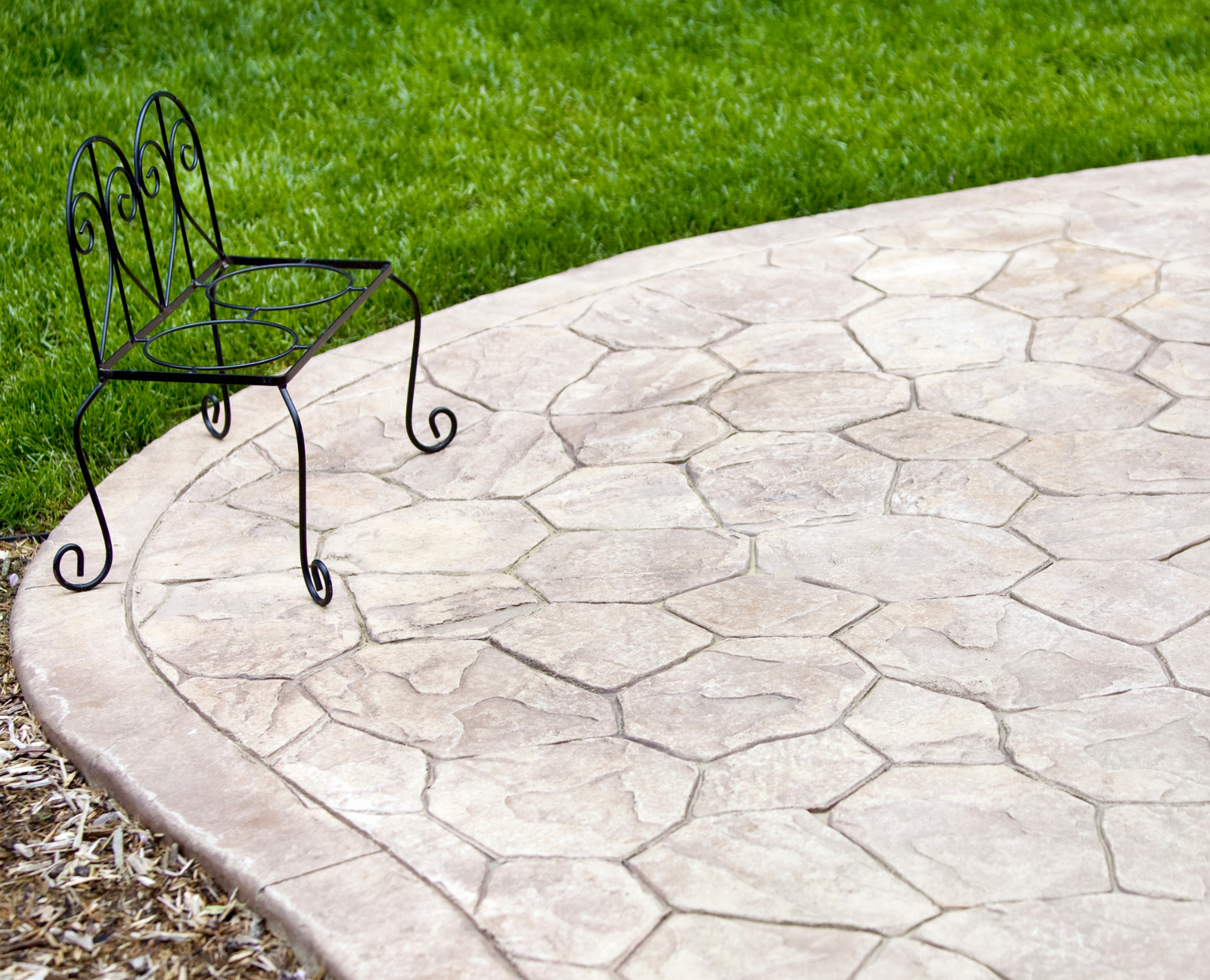
Although we value stamped concrete patios since they are inexpensive and practical, we can't hold it against designers who have other ideas. Designers naturally favor natural materials, which they aim to mimic, but it is not a perfect replacement.
According to Turner, "stamped concrete can crack over time and frequently looks artificial."
To create a patio space that a designer will approve, choose high-quality materials like large-format pavers or natural stone. These choices are more timeless and long-lasting in addition to being more aesthetically pleasing.
Additionally, Turner disapproves of patios that combine too many various elements, including plastic, wood, and metal. This may result in a visually disorganized and unwelcoming area.
"It will look like a much more cohesive and inviting space if you can stick to one or two materials that complement the home's architecture," he says.
An inexpensive all-weather wicker patio furniture is not a good option, according to Peterman's opinion. Seemingly ubiquitous, this style of furniture is frequently less expensive than its metal and wooden counterparts. But in addition to seeming a little old, it is also short-lived.
According to her, "It was popular once, but low-quality versions fail quickly and show signs of aging after their first season."
"I choose powder-coated aluminum or natural teak, and sometimes concrete-wood combinations, when building an outdoor space because they improve with age instead of deteriorating," she says.
If you've always wanted a living room that seems luxurious, know that you can definitely accomplish this style on your own without breaking the bank. The secret is a few well-considered, expertly recommended improvements that will quickly transform your area into a "luxe" haven.
For a more sophisticated look, you should use these six easy yet effective suggestions from three interior designers.
Note: Don't be shocked if your friends and relatives begin to compliment you nearly right away.
You may simply add architectural flair to your home after you move in, even if it doesn't have much. Installing molding will also make your living room look much larger.
According to Rebecca Ward, the founder of Rebecca Ward Design, "Nothing says 'expensive' like adding molding to a feature wall. It’s a custom detail that adds an extra touch of intrigue and character to the space, but doesn’t have to cost a lot!"
If you like DIYing, you can install the molding yourself, which renters can appreciate as well. You can use temporary glue to apply renter-friendly picture frame molding, which you can then remove after your lease, according to several online tutorials.
Never undervalue the impact of adding some striking flora to your house. For a posh touch, Ward loves to place a potted tree in the living room.
"Live or faux, the green is an enriching neutral color for any palette," Ward states.
Consider alternatives to a typical terracotta planter and choose one that more closely matches your style. For the ideal vessel, you may also browse vintage stores. To make the arrangement look a little more authentic, you might also want to buy some moss to put on the top of your planter if you decide to go the false plant route.
According to Elissa Hall, co-creator of Sojourn Interiors and founder of EDH Interiors, adding a range of natural textures to a living room is crucial to creating an opulent appearance.
"Working in neutrals helps create that sumptuous, elegant feel," she claims.
To further add depth and visual intrigue that conjures quiet elegance, she suggests using elements such as stoneware, wood, wool, and other materials in the room.
Studio Burgoon founder Ali Burgoon Nolan concurs, pointing out the importance of layering textiles in particular.
"Mixing high-quality natural fibers like linen, nubby wool, or mohair through drapery, throw pillows, blankets, and upholstery creates a rich, collected look," she explains.
According to Nolan, you should use the same color scheme throughout your living area to avoid making it look overly busy even with so many distinct textures.

The secret to a living room that is well-designed? Hall explains that they pay great attention to scale. Making sure the furniture you choose fits your room properly will give the impression that you hired a professional designer, even if you did all the work yourself!
The designer advises adding lots of seating to a large living area, possibly in the form of a sectional sofa and a few poufs or accent chairs. Compact seating is necessary in small living areas. Hall advises going with luxurious furnishings, such as leather or velvet.
"Say yes to oversized art pieces for a luxurious look," Nolan advises.
"A statement piece, whether an oversized painting, a hanging tapestry or textile, or mixed media, adds instant sophistication and makes the space feel intentional," she explains.
Even better, Nolan advises against purchasing your large-scale artwork from a print shop or big box store and instead recommends choosing the original or vintage approach. According to Nolan, doing so will immediately increase the feeling of luxury.
A window without drapes may appear underdressed, but one with drapes has countless benefits. In addition to providing seclusion and a simple method of blocking out sunlight, window treatments will make your ceilings appear higher and your room appear more luxurious overall.
Julie Mitchiner of JAM Interior Design says that the best way to make a space appear more expensive is to add window curtains. According to her, "Window treatments, and particularly drapery, really add a finishing layer that makes a room feel more complete."
Don't worry if you're thinking about drapes and seeing dollar signs flashing in front of you. According to Mitchiner, custom drapes aren't necessary to create an opulent atmosphere. For a cozy, opulent style, choose velvet panels and begin with common areas such as your dining room and living room.
When describing items that already have well-known names, the real estate industry enjoys inventing new, sometimes perplexing phrases. The phrase "great room" has become widely used yet is not always understood.
Although great rooms are not the same as front or living rooms, that does not imply that their functions are different.
In this post, we'll discuss what a great room is, what it is for, and more. So without further ado, let's get started!
A great room is simply a huge ground-floor space in or close to the heart of the house. Like a living room, it can include couches, comfortable seats, and a television where guests can gather. However, although a great room can function as a living room, a living room cannot always function as a great room because the area is larger than a standard living room.
As mentioned, a great room has a lot of available space which may contain various pieces of furniture and are organized into nooks and sections for multiple functions.
For instance, you might have a couch and comfy seats in a corner for family gatherings or around a fireplace for reading and resting. You could also have a bar for fun, coffee tables for dining, and specific places for kids to run and play in your great room when you have a great room.
This is because great rooms have open floor plans, which means no walls separate the various seating sections. As a result, the entire space appears spacious and inviting for multiple uses.
When it comes to great rooms, the most important thing to keep in mind is their various functions. A great room is well-suited for eating, relaxing, entertaining, living, and playing, whereas a living room can be a good spot to hang out or entertain guests.
Great rooms usually have short tables where people can sit, eat, or drink, but they're not meant to be dining rooms.
Since they are open-plan, it often leads into kitchens and eating rooms.
These are ideas you can consider if you're uncertain if a great room will take up too much space or how to make the most of that space.
You should make each great room feel different, even though they should be connected to the other rooms in your home. This can be done very well by choosing the specific transitions.
Changing the kitchen or dining room's lighting or flooring can also help maintain its ambiance. One quick way to tell that the space has changed is with roof beams and decorative arches.
There are many ways to divide a big room into different areas, each with its color scheme, wall trim, and furniture. The great room can feel cozier and easier to handle if warm colors are used around comfortable chairs and cool colors are used around larger sitting areas.
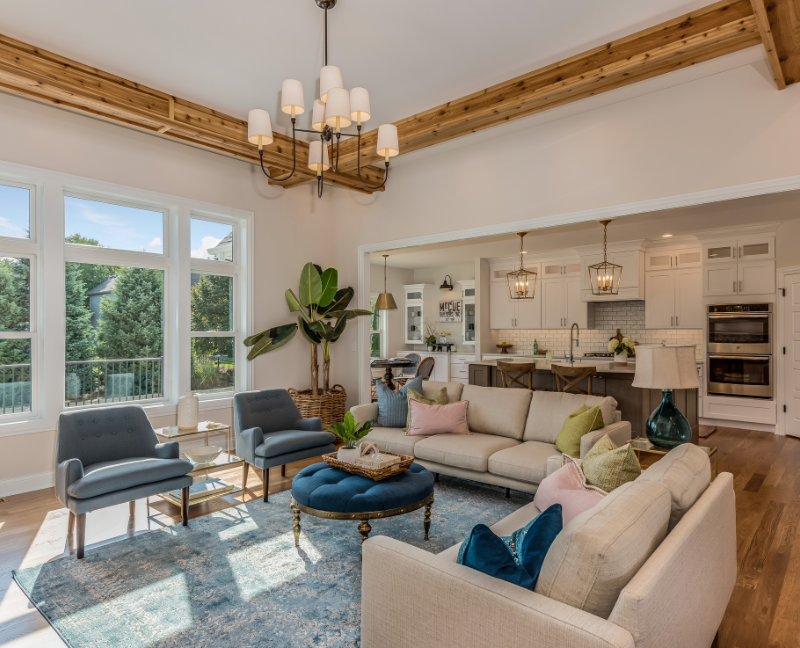
There's nothing worse than sitting against a wall and feeling like you're ten feet away from the nearest person. One of the best things about a great room is that it can have floating furniture. Opening sofas, tables, and chairs can make the space more inviting. This is especially true for great rooms with a lot of square footage.
If you want more natural light in your home, great rooms are a great way to do it while also using less electricity to light the room. That's because great rooms usually have big windows on the outside walls that let in a lot of light. In addition, there are no inner walls so the light can bounce freely.
Want to learn more about great rooms? Visit our website for free resources.
Doorbell cameras are popular but does everyone, specifically real estate brokers, like them?
In this post, we'll find out what our real estate experts really think about these high-tech devices and whether they love or hate seeing these security gadgets on their listings.
When they see your camera, some folks might wonder why you feel the need for one. “Is it a deterrent for crime or a neighbor taking your morning newspaper?” says Coldwell Banker Warburg broker Steven Hoffman. "This could lead to buyers having unpleasant questions at the beginning of the home tour," she added.
Your camera may make your space feel more like a reality TV show than a home, according to Mihal Gartenberg, a Coldwell Banker Warburg broker. He explains that buyers may feel that they need to "be cautious about how they behave and, even more importantly, the things they say to each other about the home," which may make it more difficult to imagine themselves living there.
Broker Suzanne Weinstein believes that some homeowners face the risk of entering into an arrangement where the neighbors are already a little turned off by your presence. After all, nobody wants to start on the wrong foot. "Video-audio recording devices violate most proprietary leases that prohibit causing a nuisance or interfering with the quiet enjoyment (and right to privacy) of neighbors," she argues, pointing out that doorbell cameras such as Amazon Ring record private conversations.
According to Massachusetts real estate agent Jennifer Baptista, real estate brokers enjoy asking their clients about their initial impressions, but they are unable to do so when the homeowner is watching and listening. "It's challenging because I prefer to understand my clients' viewpoints in real-time," she adds, adding that she frequently loves to inquire about their "first impressions" as they approach the front door.
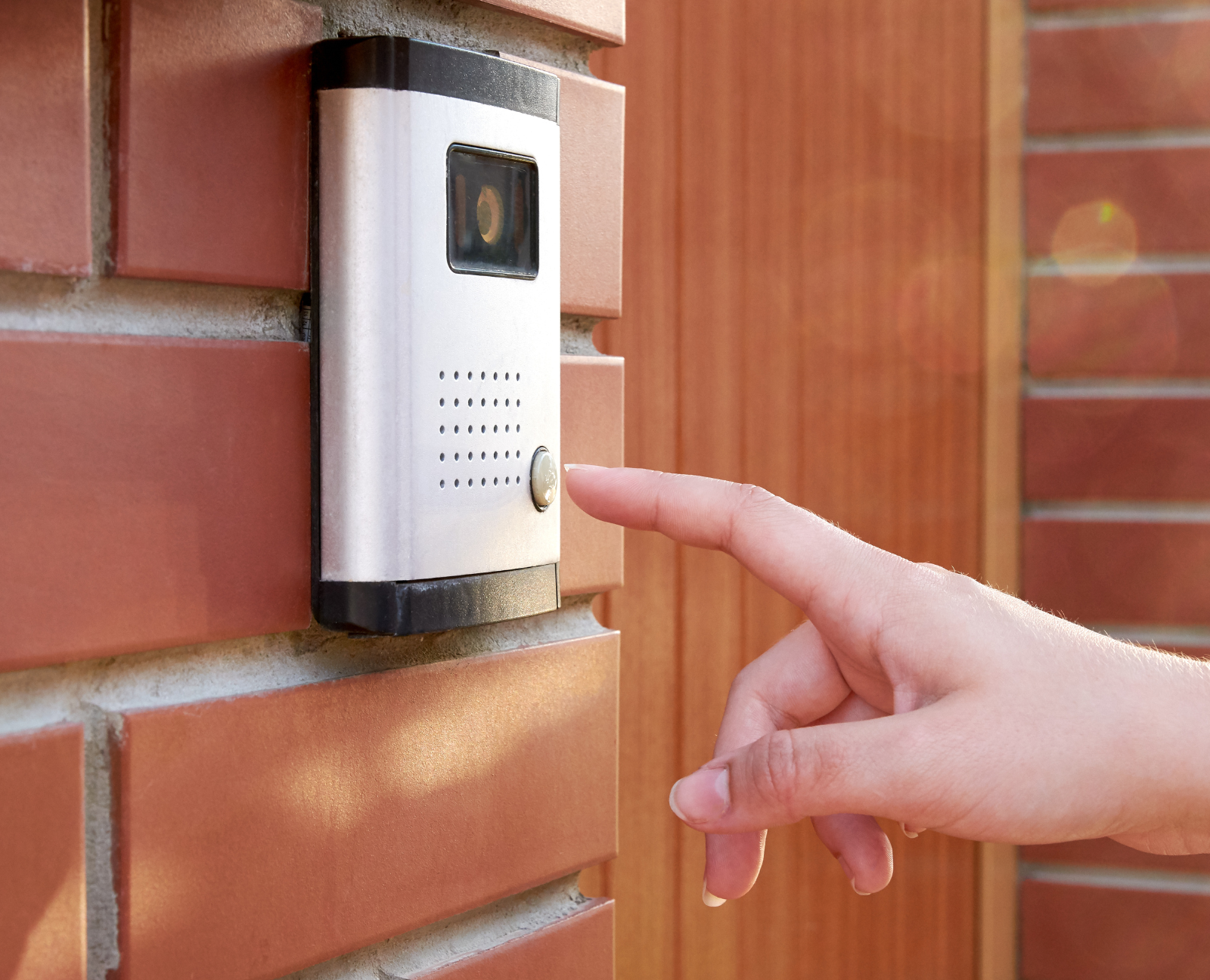
They can help homeowners feel a little more at ease about opening their homes to strangers, which is the major reason Heather Malone, who works with Coach Realtors on Long Island, doesn't mind seeing them at listings. "At times, a home may be showing when it is vacant, and it is always good to keep an eye on your asset when you’re not there," she explains.
Additionally, an agent and seller may decide to maintain a lockbox on the property. When this occurs and neither the seller nor the listing agent is present to show the house, it is beneficial to find out which agents were in and out of the property during that period and whether there were any problems when the seller returned home.
According to Mike Robinson of Century 21 AllPoints Realty in Connecticut, doorbell cameras make a nice parting gift, even though some real estate agents may have unfavorable opinions about them. He explains, "I give them as closing gifts because I deal with a lot of out-of-state buyers." “I am big on personal safety and security and figure if someone is new to a neighborhood, the best way to give them some peace of mind is the ability to watch their front door 24/7, no matter where they might be.”
Avoiding porch pirates is a top concern for many individuals since, as we can all agree, we spend a lot more time clicking "add to cart" these days than we do browsing the store's aisles. "In addition to addressing safety issues within the house, doorbell cameras also reduce package theft in the neighborhood as a whole," explains Jaime Jones and Julie Mariani Cassel of J+J Team Homes. 49 million Americans were robbed by porch pirates in the previous year. Last year, an estimated $2.4 billion worth of merchandise was stolen from porches across the United States.
According to Compass Broker Kimberly Jay, doorbell cameras have become very commonplace due to their affordability and popularity. Doorbell cameras are standard equipment in single-family homes, townhouses, and non-doorman buildings. "Anyone can buy one from a big box store for less than $100," she adds, adding that they can give the impression that the sellers are tech-savvy or intelligent.
How about you? What are your thoughts about the doorbell camera? Would you have that security device in your home or not?
With a solid checklist and smart planning, you can stay organized, reduce stress, and even enjoy the process a little (yes, really). Whether you’re moving across town or across the country, this moving checklist will help you start now—so you’re not scrambling later.
Start early, follow a plan, and you’ll thank yourself later.
Moving is a lot, but it doesn’t have to be a mess. With a timeline, a checklist, and a little planning, you’ll stay one step ahead—and that’s half the battle.
As we Spring Forward this weekend and adjust our clocks, it’s also the perfect time to start thinking about springing into your next move! Whether you’re buying or selling, spring is a fantastic time to make things happen in real estate. At RE/MAX Advanced Realty, we’re here to guide you through the process with helpful tips and a fresh perspective to make your transition smooth and successful.
For Buyers:
Spring brings more homes onto the market, giving you a wider range of options to choose from. Plus, with the weather warming up, it’s a great time to explore neighborhoods and see homes in their best light.
For Sellers:
Spring is a prime time to sell your home. Homes look their best with blooming gardens and longer daylight hours. Buyers are out in full force, eager to find the right place to settle into. The competition is fierce, so this is your chance to showcase your property to its fullest potential.
Tips for Buyers:
Start Your Search Early:
Spring is a busy time in real estate, so begin your search early to get ahead of the competition. Know your budget, get pre-approved for a mortgage, and have a list of must-haves ready to go.
Don’t Forget to Look Beyond the Listing:
While pictures and descriptions are important, nothing beats seeing the property in person. Take your time exploring the neighborhood and the home’s potential.
Get Your Home Ready:
First impressions matter! Clean up your home, take care of any minor repairs, and consider sprucing up the garden. These small improvements can make a big difference in how quickly your home sells.
Price It Right:
Work with your agent to set a competitive and realistic price. Homes that are priced correctly tend to sell faster, especially when the market is active in the spring.
Our Most Recent Listings:




Looking for more options? Visit www.indianapolisrealestate.com to explore all available listings and find the home that’s right for you. Whether you’re searching for a cozy starter home, a spacious upgrade, or the perfect investment, we’ve got something for everyone!
What’s Next?
If you’re ready to make a move this spring, we’d love to help you every step of the way. Whether you’re buying or selling, RE/MAX Advanced Realty has the experience and knowledge to help you navigate the process with confidence. Reach out today, and let’s get started!
In today's competitive market, it's critical to optimize your home's value, and one of the best ways to do this is by implementing smart landscape design.
Enhancing the curb appeal gives potential homebuyers a good first impression. On top of making it more appealing, a beautiful, well-kept yard adds value to your home.
It doesn't matter how big or small your yard is; there are tips you can easily follow to turn it into a beautiful space. The best part is that you can find landscaping and gardening projects here that suit your needs and budget, so without further ado, let's get started!
As they say, "first impressions last." When a guest enters your home, the first thing they notice is the front entrance. That said, a welcoming environment is important as it sets the vibe for your entire home. A simple paint job can help!
Adding vibrant followers and plants helps increase your curb appeal, too. You can also use seasonal flowers and evergreen bushes to add color throughout the year. Including low-growing shrubs or blooming plants in the entrance can make your walkway even more welcoming.
Native plants are excellent for environmentally friendly landscaping. They require little maintenance and adapt well to the local climate. These plants are acclimated to the local soil, rainfall, and temperature fluctuations. This implies that you don't need to give them a lot of water, fertilize them frequently, or deal with pests as much.
Your landscaping's environmental impact can be reduced by using native species. You also benefit from their inherent strength. These plants can withstand local pests and illnesses better and typically require less water, making it easier for you to maintain your landscape.
Outdoor lighting is not just for safety and security; it also adds a touch of aesthetic appeal to your yard at night.
With good outdoor lighting, you, your family, and visitors can move around safely when driveways, pathways, and entryways are well-lit.
But safety isn't the only consideration. The design of your house can be enhanced by smart lighting. It can draw attention to important areas of your yard and give the scene more depth. To create a visually appealing and multi-layered lighting design, consider utilizing spotlights, path lights, and string lights.
These days, outdoor living areas are increasingly popular. A thoughtfully designed patio or deck can significantly raise the value of your house. These spaces let you party, unwind, and experience outdoor living without actually leaving your house. Your indoor space can be expanded with a patio or deck, allowing you to move with ease indoors and outdoors.
Consider including elements, like cozy patio furniture, outdoor kitchens, or fireplaces in your patio or deck design. These accessories can improve the utility and appeal of your outdoor area. Anyone wishing to purchase your house will find it more appealing as a result.
Many homeowners desire a lawn that is both attractive and healthy. Your grass will always receive enough water thanks to an irrigation system.
Since the irrigation system reduces the need for manual watering, you are already saving time and energy. Additionally, a properly built irrigation system irrigates your lawn uniformly. By doing this, too much or too little water is avoided.
These days, conserving water is crucial. Smart features are a common element of modern irrigation systems. Rain sensors and timers are among these features. They reduce waste, improve water use, and benefit the environment.
Edible gardens, sometimes known as kitchen gardens, have gained popularity recently. Living sustainably is becoming more and more popular. Imagine gathering fresh fruits, veggies, or herbs for your meals in your garden. Not only do you have a unique and fulfilling experience with a garden of your own, but you also have an abundant, aesthetically pleasing backyard.
Consider a few factors when designing your kitchen garden, such as the sunshine required by the plants, the product you wish to grow, and the kind of soil you have. An excellent option is a raised garden bed. They are simpler to maintain and provide excellent drainage.
A good landscape always includes a tree. They provide privacy, shade, and a pleasant appearance. A mature tree can significantly increase the value of your house as it makes your living area more appealing and pleasurable.
Trees can cool your house in the heat if you place them in the proper locations. Your air conditioning expenses may go down as a result.
Additionally, trees serve as organic privacy barriers. They help reduce noise and protect your home from intruders. When selecting trees, it's a good idea to consider their potential growth size and suitability for your local climate.
Paths and walkways are practical and improve the aesthetics of your landscape. They can connect various areas of your yard, facilitate visitor movement throughout your outdoor area, and enhance the overall appearance. People are encouraged to explore and take in your landscaping by these characteristics.
Consider selecting materials for your walkways and paths that complement the design of your house and the surrounding area. Flagstone, pavers, gravel, and stepping stones are popular options.
A fire pit is a wonderful place to gather with loved ones. It's also essential for maintaining safety and sustaining the fire.
Other than that, it provides warmth, a pleasant sensation, and everlasting enjoyment. Spending time with loved ones, sharing tales, and sitting around a roaring fire is a unique experience.
Make sure you have ample seats as you set up your fire pit area. To provide more seating, you could include features like benches or a wall.
Your landscape design might become more serene with the addition of water elements. The region is calmed by the gentle sound of flowing water. Blocking out loud noises might also be beneficial.
Small fountains and huge waterfalls are both options. Your budget and style can be accommodated by a variety of possibilities. You may enhance the beauty of your water feature by adding aquatic plants. Additionally, these plants provide a habitat for beneficial species, such as frogs and dragonflies.
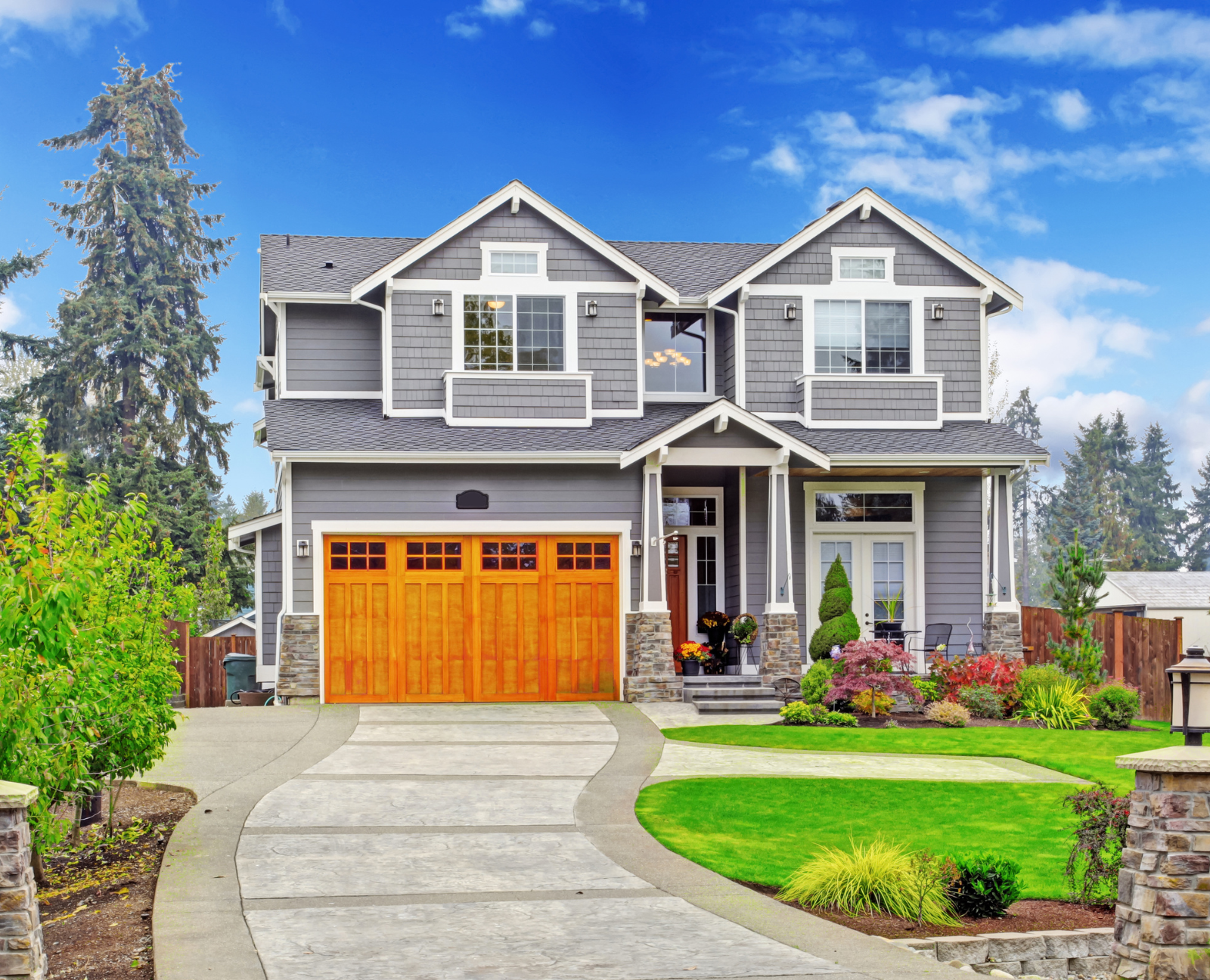
Increasing the value of your house and attracting potential purchasers depend heavily on curb appeal. Because buyers notice your home's exterior and landscaping first, it's important to make a favorable impression. Not only does well-designed landscaping look good, but it may also make buyers feel proud and at ease. This emotional bond might inspire people to envision creating joyful memories in their new house.
In this part, we will talk about the importance of first impressions and some useful tips on choosing the right plants. By doing this, you can make your curb appeal more appealing to potential homeowners.
First impressions are crucial in the real estate industry. How prospective buyers initially feel about your property can have a big impact on what they think. This may have an impact on their decision to make an offer. It displays pride of ownership if the exterior is attractive and well-maintained. It implies that the interior is likewise taken care of. However, a disorganized and neglected front yard could give the impression to potential buyers that the house is not well-maintained and that costly repairs are required.
Buyers may remember the first few seconds they spend viewing your house. They can use this time to determine the worth of your property and whether they wish to explore more. An attractive exterior facilitates the development of an emotional connection. This increases the likelihood of a successful transaction and a positive viewing experience.
Finding the right plants to enhance the curb appeal of your home is important. It also contributes to the creation of a lovely landscape design. Consider your preferences, the style of your home, and the neighborhood before you visit the nursery as well as factors, like the type of soil, the amount of sunlight the plants will receive, and the size of the plants. They will thrive in the locations you designate in this manner.
Select a variety of deciduous and evergreen plants. Like shrubs, evergreens provide a pleasing backdrop and shape for vibrant flowers. In addition to offering stunning foliage in the fall, deciduous trees may offer shade throughout the sweltering summer months. In addition to lowering your workload, adding native plants will draw beneficial pollinators.
Homeowners today are more environmentally conscious; even when it comes to homes, they want it to reflect their values.
Eco-friendly landscaping benefits the environment plus, it also increases the value of your house. This is accomplished by drawing in eco-conscious customers, conserving water, and reducing maintenance expenses. You demonstrate that you take responsible ownership seriously by employing these landscaping techniques. You also improve the health and appearance of your property.
The advantages of implementing sustainable landscaping in your outside area are covered in this section. It provides easy ways to protect the environment and increase the value of your home.
Native plants have adapted and matured to thrive in particular environments. They are ideal for the soil and climate of the area. These plants require fewer pesticides, fertilizers, and water than non-native plants since they are accustomed to the local environment. Eventually, this saves you time, money, and effort while also making your work easier.
Native plants are often recommended by landscape designers and architects. In addition to its ecological advantages, they can attract beneficial insects and wildlife. For pollinators such as hummingbirds, butterflies, and bees, native plants provide both food and habitat. This contributes to the development of a robust ecosystem.
Water conservation is crucial for beautiful landscaping, particularly in areas with water constraints or drought. By adopting intelligent watering techniques, you may create a garden that thrives even in arid environments while conserving water. An effective irrigation system is a fantastic way to conserve water.
Plants that require the same amount of water should be in a group. This improves the irrigation system's performance. Mulching plants is also beneficial. It prevents weed growth, maintains soil moisture, and stabilizes soil temperature, all of which reduce water evaporation. To avoid wasting water, frequently inspect your irrigation system for leaks or other issues.
Nowadays, having an outdoor living space is considered a necessity rather than a luxury. They provide a tranquil setting for unwinding and taking in the scenery without leaving the comforts of home. The desire for homes with comfortable outside spaces has increased in the real estate market. This modification demonstrates how much these areas can increase the value of real estate. In addition to making your life better, well-designed outdoor living areas can increase the number of potential purchasers.
Outdoor living spaces have evolved significantly. Nowadays, homeowners transform their backyards into entertaining areas that complement their lifestyle. They desire outdoor spaces that bridge the gap between interior and outdoor living. This makes the transition between houses and the natural world seamless. Features like fire pits, comfortable seats, and outdoor kitchens have therefore gained popularity.
Weather-resistant furniture, outdoor lighting, and sound systems are becoming more and more necessary as a result of the trend of combining interior and outdoor areas. These components contribute to the practicality and friendliness of outdoor spaces. You may improve your enjoyment of your outside space and raise the value of your house in the real estate market by incorporating these trends.
For homeowners who want to improve their outside living space and increase the value of their house, investing in a deck or patio is a smart move. Particularly in areas where outdoor living is highly desired, real estate brokers frequently highlight the substantial return on investment that accompanies a well-built deck or patio. When they sell their house, homeowners should anticipate receiving a sizable return on their investment, according to the National Association of Realtors (NAR).
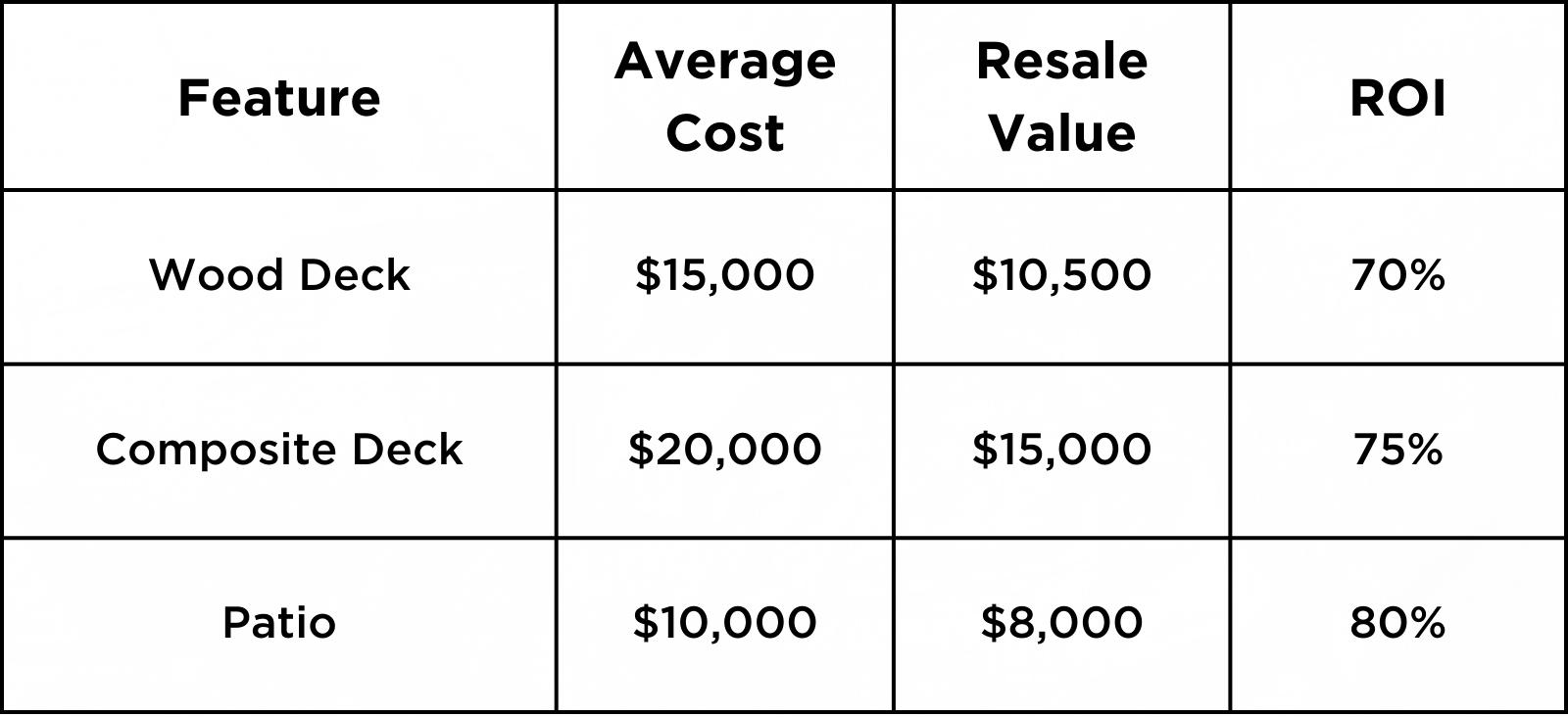
In addition to expanding your living area, adding a deck or patio improves the curb appeal of your home and boosts its attractiveness to potential purchasers.
In addition to being aesthetically pleasing, landscaping is essential for functional reasons. Adding practical upgrades can significantly increase the value of your house. To solve issues, provide seclusion, and create a more comfortable outdoor space, useful landscaping entails utilizing hard surfaces and plants in clever ways. Your home's market worth increases when you concentrate on these factors since you not only make it more useful but also draw in potential purchasers.
Below, we'll talk about the importance of trees and shrubs in landscaping as well as tips for enhancing privacy that can raise the aesthetic appeal and market value of your house.
Shrubs and trees are essential to any well-designed landscape. In addition to adding beauty and structure, they raise the value of your house. The ecosystem can benefit from tree planting. They offer shade, lower noise levels, and enhance air quality. Energy expenses can be further reduced with this hue. In real estate, mature trees are very significant.
Shrubs are versatile in landscape design because of their wide range of sizes, forms, and colors. They can be used as privacy hedges, to soften the appearance of your house, or as striking garden accents. They also increase the value of real estate.
For your outdoor area to seem serene and isolated, privacy is crucial. In addition to being aesthetically pleasing, landscaping can assist increase the privacy of your property. Utilizing these components in your landscape design enhances your home's aesthetics, functionality, and value in addition to keeping strangers out. This is a plus for buyers since they typically search for privacy.
Planting hedges is a fantastic technique to create a natural screen. Evergreens that provide year-round privacy, such as holly, boxwood, and arborvitae, are good choices for hedges. For more privacy, you might also install climbing vines on a wall or fence. Consider creating a vertical garden or living wall for a more organic look. In addition to providing privacy, this gives your outdoor area a distinctive and pleasant appearance.
To sum up, landscaping may significantly raise the curb appeal and value of your house. You may do this by including functional outside areas, native plants, outdoor lighting, and a cozy front entry. These adjustments can improve the aesthetics and environmental friendliness of your house. Your yard can become more charming and serene by adding water features, fire pits, and lovely walkways.
In addition to improving the appearance of your house, smart landscaping can also increase its value. For a higher return on your investment, use native plants to benefit the ecosystem and adhere to outdoor living trends. Create neat and beautiful landscaping that reflects your personal style and raises your home's worth.
Placing a "For Sale" sign in the yard and waiting for offers isn't the only thing involved in selling a house. You need a strategy if you want to sell it for top dollar. These ten professional-backed suggestions will help you increase the value of your home and draw in the right purchasers, whether you live in Indiana or elsewhere.
Let's get started!
Have you ever driven by a house and made an instant judgment? The same is true for buyers. The good news? A few minor adjustments can have a big effect.
Local Tip: Homes with excellent curb appeal in Indiana neighborhoods like Indianapolis and Fishers typically sell more quickly and for more money.
Buyers don't want to see that pile of mail on the counter or your enormous collection of fridge magnets. They want to visualize a place they can live in.
Here are the things you can do:
Before selling, not every improvement is worthwhile. Although a complete kitchen makeover is unnecessary, minor adjustments might yield significant benefits.
Have you ever noticed how welcoming model homes feel? That is all because of staging. Although hiring a professional is not necessary, a little work goes a long way.
We understand that everyone wants to sell their house for the most money. However, putting a home on the market for too long might make it stale, and overpricing will turn off buyers.
Work with a local expert or real estate agent (a.k.a. US) to price it competitively from the start rather than setting your sights too high and running the danger of price reductions later.

The days of just posting a listing on real estate websites and moving on are long gone. Your house needs to look amazing online if you want high-ball offers.
Consider these:
We understand that having strangers wander through your house at unexpected times is bothersome. However, your chances of receiving a fantastic offer increase with the number of showings.
The shaky stair railing or the leaking faucet will be noticed by buyers. Fix the simple things now rather than waiting for a house inspection to reveal problems.
A house with lower utility costs is a big selling point. That said, make sure to emphasize any energy-saving improvements you've made in your listing, such as:
Customers searching for long-term savings may be won over by these minor features!
Without a doubt, you can sell your house on your own, but do you really want to handle all the paperwork, negotiations, pricing, and marketing by yourself?
An experienced agent, like us here at RE/MAX Advanced Realty, is aware of:
With the proper team by your side, selling your house doesn't have to be a daunting task. RE/MAX Advanced Realty can assist you whether you want to identify the ideal community for your next move, enhance the value of your house, or make the selling process go smoothly.
Are you prepared to move forward? For a free home appraisal and customized selling plan, get in touch with us right now! Let's discuss your objectives and come up with a plan that will get you the best deal.
Whether you're craving a cozy retreat, a home filled with character, or a stylish modern escape, there's no better time to find a space where your heart truly belongs.
Your dream home is more than just a place to live—it's where memories are made, where laughter fills the rooms, and where every corner brings a sense of peace and comfort.
Imagine cozy evenings by the fireplace, lazy Sunday mornings with coffee on the porch, or hosting family gatherings in a space that feels just like you.
This February, fall head over heels for a new place to call your own. Browse through our featured listings, and discover a home that speaks to your heart, your lifestyle, and your future.

🏡 243 S Madison Ave, Greenwood | $2,399,000
Step into a piece of history with this iconic property. Originally built in 1850 and completely rehabbed to preserve its charm, this property offers nearly 2 acres in the heart of Old Town Greenwood. Perfect for an event center, bed and breakfast, or redevelopment, this is a rare opportunity to own a prime piece of land with unlimited potential.

🏡 11383 Sea Side Ct, Fishers | $824,000
A stunning 5-bedroom, 3.5-bath home in Bayview Estates, just steps from Geist Reservoir! Built for entertaining, with a spacious open concept, gourmet kitchen, and walk-out basement featuring a wet bar. Perfect for creating unforgettable moments with family and friends.

🏡 4104 W Fox Trl, Trafalgar | $549,900
For nature lovers, this custom-built home on 1.75 acres offers not just a home but a lifestyle. Enjoy full lake privileges, a cozy fireplace, and an expansive screened balcony—perfect for those seeking a peaceful retreat surrounded by nature’s beauty.
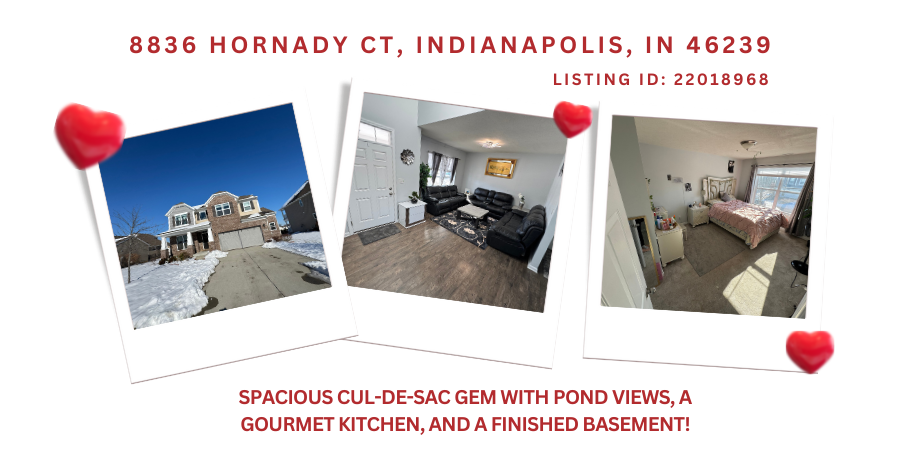
🏡 8836 Hornady Ct, Indianapolis | $425,000
This 4-bedroom home features stunning pond views, a spacious kitchen, and a fully finished basement. Ready for entertaining, with cozy family areas and plenty of room to host guests, making it the perfect backdrop for any occasion.
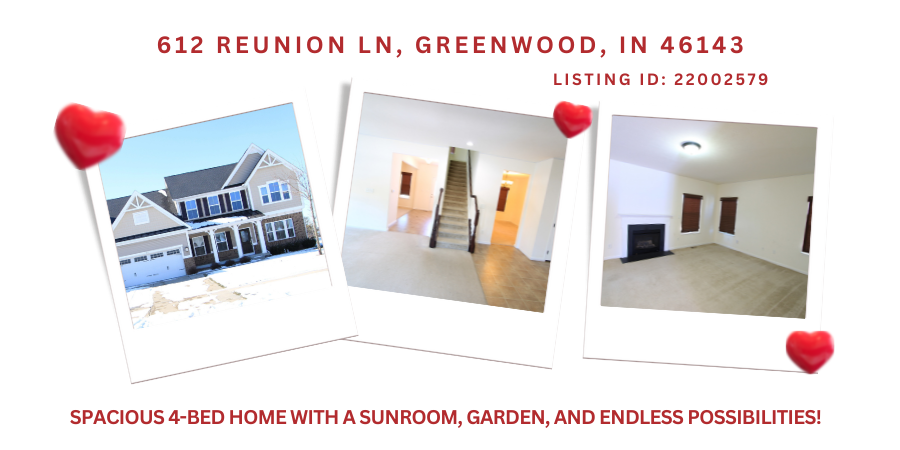
🏡 612 Reunion Ln, Greenwood | $424,498
A sun-filled 4-bedroom, 2.5-bath home with a vegetable garden, spacious basement, and warm, inviting character. This home offers the perfect mix of peaceful relaxation and entertaining possibilities—ideal for making memories.
Whether you're looking for more space, a fresh start, or the perfect cozy retreat, your dream home is out there—and we’re here to help you find it.
Don’t let the love month pass without taking the next step toward a home that truly fits your lifestyle.
If these listings aren’t quite what you’re looking for, let’s find the one that is.
We’re ready to create a customized home search and guide you every step of the way to make sure you find the perfect match.
📩 Let’s get started—tell us what you need, and we’ll help you find the home that checks all the boxes.

8313 W. 10th St
Indianapolis IN 46234
dennis@indyhomepros.com
317-316-8224